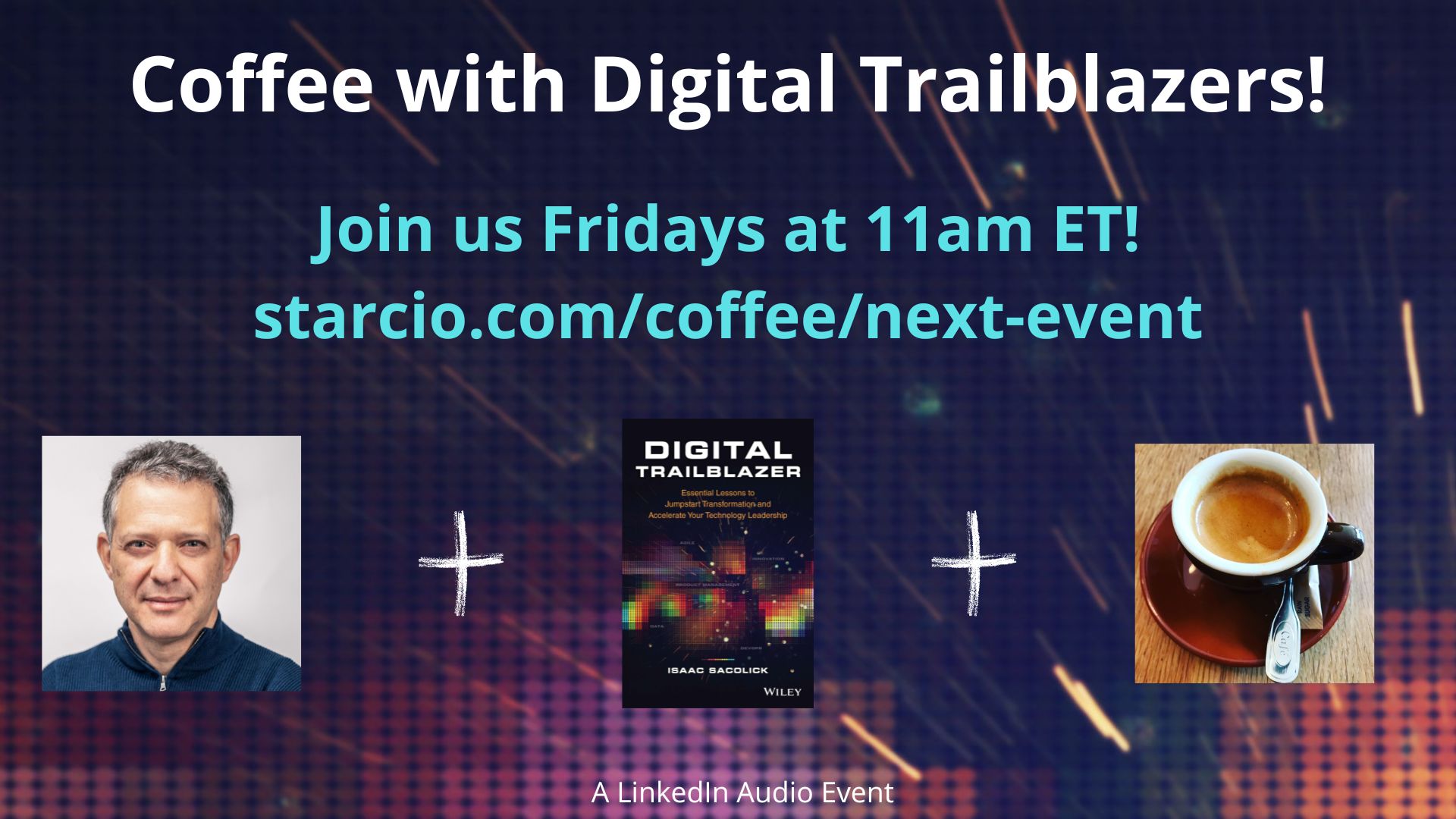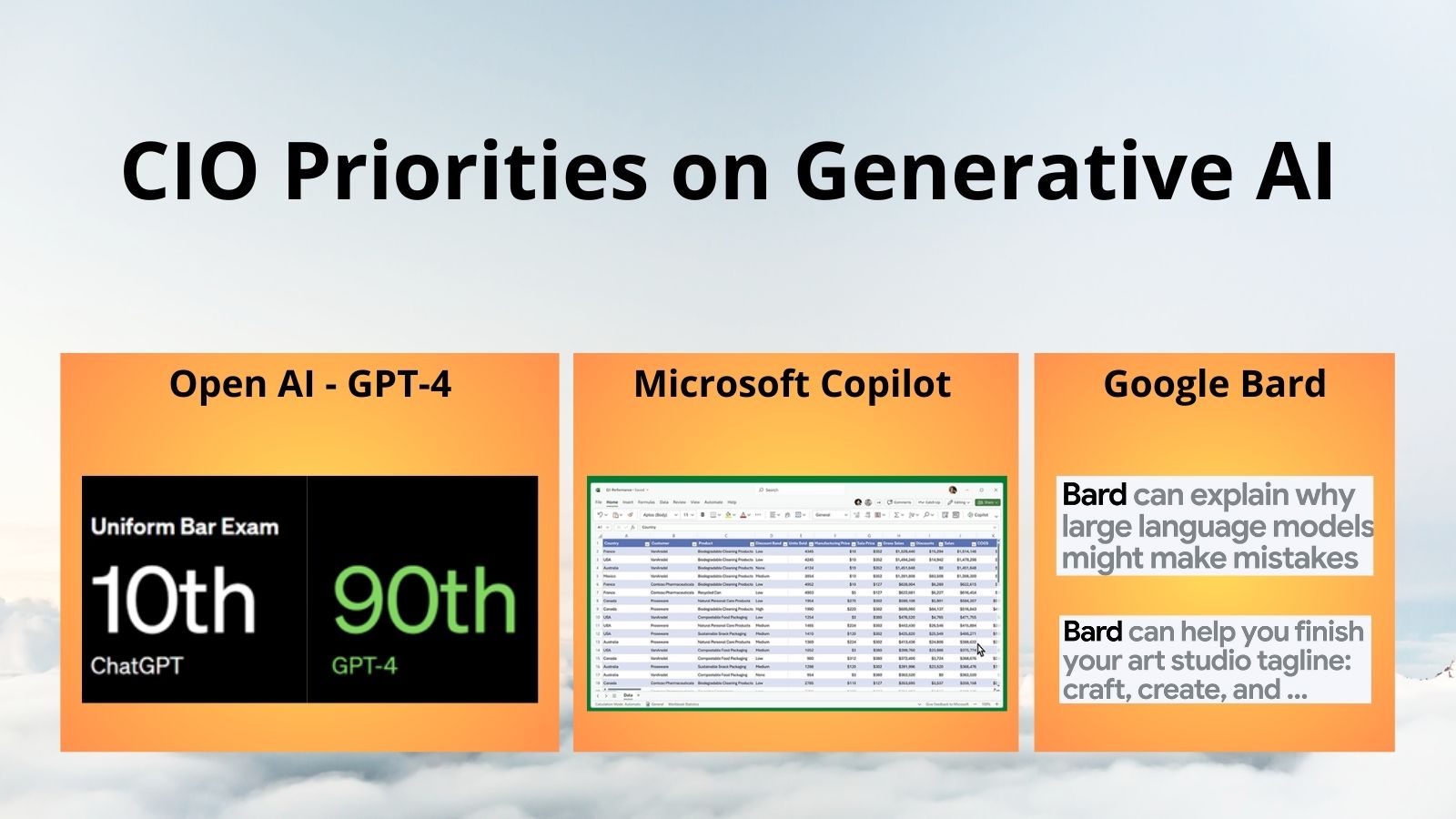How should CIOs and IT leaders prepare their organizations to pursue
generative AI opportunities while mitigating risks and navigating cultural
and workforce impacts?
It’s a top-of-mind question for every CIO, especially as Boards ask about
company AI strategy, while 51% of CEOs expect their CIOs to lead the company’s AI efforts.
Generative AI is at the peak of Gartner’s Hype Cycle and likely one of the fastest transitions from emerging tech to peak. On one side, CIOs must be concerned about shadow AI and the risks of sharing intellectual property with an open AI platform. Conversely, there’s the pressure to quickly define an AI strategy and deliver business impacts from AI investments. In the middle is addressing employee questions about AI, some concerned about job security, and others who want to experiment with AI tools without poorly defined objectives.
And, of course, AI technology is changing rapidly, so Digital Trailblazers and CIOs must dial up their lifelong learning skills to keep up with the latest announcements.

CIOs and Digital Trailblazers should document a Gen AI strategy and
vision statement. Below are several focus areas I recommend, starting from risks to address
now, short-term opportunities, and through longer-term innovation
impacts.
Now: Understand and manage gen AI risks
Gen AI and LLMs are among the few technologies with high-velocity hype and
buzz across multiple dimensions. CEOs at the top seek game changers,
employees want to try the latest AI tools, and an oversupply of startups
target business leaders to try and buy their AI technologies.
CIOs and Digital Trailblazers should seek controlled experimentation,
educate employees on the risks, and invest in
proactive data governance. During a recent
Coffee with Digital Trailblazers, we discussed these and other AI risks and captured the group’s
recommendations in my post,
three key risks to address to experiment with Generative AI safely.
Because of the hype and the material risks to intellectual property, I believe the CIO’s AI strategy and vision statement must start by communicating the guard rails and outlining procedures for gen AI experimentation.
Today: Generative AI making a significant impact in IT
The easy place to start on immediate gen AI impacts is in your backyard by reviewing how generative AI, LLMs, and copilots can improve developer productivity, code quality, and innovation. In a recent post, I shared 10+ LLM and gen AI capabilities for DevOps and IT Ops, including finding problem root causes, simplifying incident response, and updating IT policies.
But in dev, we will likely see the greatest transformational impacts.
Consider the efficiencies and innovation gained over the last 25 years from
the dawn of web app development:
- Hard coding in simple code editors and deploying with a mix of scripts and manual steps
- IDEs with built-in code navigation and error-checking capabilities
- Open source libraries, applications, and services that enable significant reuse of other people’s code
- Cloud, serverless computing, and DevOps automation reduce the work of building, testing, and deploying software.
- Low-code and no-code development simplifies the skillset to build apps, dashboards, and SaaS integrations.
All these innovations drove productivity and capabilities to build and
deploy applications while lowering the bar on the required skill sets.
Now, LLMs and copilots enable developers to search frameworks and libraries,
ask for code samples, and review code for improvements. Instead of writing
code (or no-code or low-code), I can prompt and ask for capabilities and
have a copilot reply with a starting point for my solution. It will be a
game changer for architects, engineers, developers, and test
automation.
Soon: Increase the frequency of blue sky planning and brainstorming
Remember when strategic planning was a top-down, once-a-year activity
that produced a strategy and a handful of prioritized investments? That gave
way to quarterly planning, and many larger enterprises implemented the scaled
agile framework’s PI planning.
I believe AI and digital transformation require much more frequent planning
cycles. My company,
StarCIO, guides innovative businesses
on agile continuous planning where teams, groups, and departments are encouraged to schedule a
percentage of every sprint toward planning and brainstorming
activities.
One of my five critical priorities for CIOs to lead on generative AI and ChatGPT is to increase the frequency of blue sky planning. Every week, there
are new AI breakthroughs and announcements from tech platform companies
about their new-gen AI capabilities. The bottom line is that what we
planned last week may need tweaking or pivoting based on this week’s
news.
One way to close this gap is by instituting controlled experimentation on gen AI tools in areas prioritized for experimentation. One key area is marketing, where gen AI already significantly impacts lead generation, content generation, and campaign management. Another is in customer service, where LLMs help cut across multiple platforms and enable agents to prompt for accurate customer information. But LLM’s biggest short-term business impacts will come as more organizations implement AI search across their information sources and find opportunities where more informed employees deliver exponential business outcomes.
Plan: Review strategic opportunities with LLMs
These impacts will take time as developers and data science teams must learn
about embeddings, vector databases, and interfacing with large language
models. I believe these technologies will significantly impact how
organizations build new capabilities by harnessing their unstructured data
repositories and potentially delivering even more value than the benefits of
self-service BI on relational data in SQL databases.
I rate this as “plan” because LLMs themselves have short and longer-term
innovation horizons. For example, in the short term, customers and employees
will expect natural language search capabilities built into every SaaS, tool, and consumer interface - what I call
the consumerization of search.
In the longer run, there will be multiple industry LLMs for healthcare,
banking, education, and other information-rich industries for businesses to
leverage and augment.
The age of AI transformation is upon us, and if you aren’t already experimenting with gen AI, you’ve missed the starting gun. Define an AI vision or strategy so that AI experiments evolve into your organization’s next digital transformation force multiplier.
Join us for a future session of Coffee with Digital Trailblazers, where we discuss topics for aspiring transformation leaders. If you enjoy my thought leadership, please sign up for the Driving Digital Newsletter and read all about my transformation stories in Digital Trailblazer.
 Digital Trailblazers! Join us Fridays at 11am ET for a live audio discussion on digital
transformation topics: innovation, product management, agile, DevOps,
data governance, and more!
Digital Trailblazers! Join us Fridays at 11am ET for a live audio discussion on digital
transformation topics: innovation, product management, agile, DevOps,
data governance, and more!





No comments:
Post a Comment
Comments on this blog are moderated and we do not accept comments that have links to other websites.